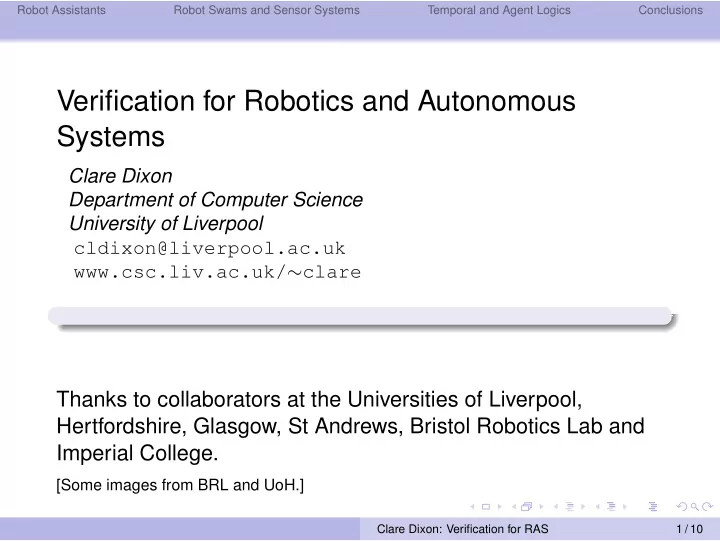

Robot Assistants Robot Swams and Sensor Systems Temporal and Agent Logics Conclusions Verification for Robotics and Autonomous Systems Clare Dixon Department of Computer Science University of Liverpool cldixon@liverpool.ac.uk www.csc.liv.ac.uk/ ∼ clare Thanks to collaborators at the Universities of Liverpool, Hertfordshire, Glasgow, St Andrews, Bristol Robotics Lab and Imperial College. [Some images from BRL and UoH.] Clare Dixon: Verification for RAS 1 / 10
Robot Assistants Robot Swams and Sensor Systems Temporal and Agent Logics Conclusions Verification and Validation of Robotic Assistants The EPSRC funded Trustworthy Robot Assistants Project developed three different approaches to verification and validation of robot assistants together aiming at increasing trust in robot assistants. Formal Verification (UoL) Simulation-based Testing (BRL) End-user Validation (UoH) � at UoH) We focused on two use cases domestic (Care-O-bot R and manufacturing (BERT at BRL). Clare Dixon: Verification for RAS 2 / 10
Robot Assistants Robot Swams and Sensor Systems Temporal and Agent Logics Conclusions Formal Verification A mathematical analysis of all behaviours using logics, and tools such as theorem provers or model checkers. Model checkers are a fully automatic, algorithmic technique for verifying temporal properties. Input is a model of the system and a property to be checked on that model. Property holds or Model Checker counter example Property eg "always p" We also develop and apply theorem provers where logical formulae are used to represent both the system and the required properties and mathematical proof is used to show that the properties hold. Clare Dixon: Verification for RAS 3 / 10
Robot Assistants Robot Swams and Sensor Systems Temporal and Agent Logics Conclusions Simulation Based Testing This is an exhaustive testing methodology widely used in the design of micro-electronic and avionics systems. These appeal to Monte-Carlo techniques and dynamic test refinement in order to cover a wide range or practical situations. Tools are used to automate the testing and analyse the coverage of the tests. Clare Dixon: Verification for RAS 4 / 10
Robot Assistants Robot Swams and Sensor Systems Temporal and Agent Logics Conclusions End User Validation This approach involves experiments and user evaluations in practical robotic scenarios. Scenarios relating to robot human interaction are developed to test some hypothesis and experiments with users carried out. This helps establish whether the human participants indeed view the robotic assistants as safe and trustworthy. Clare Dixon: Verification for RAS 5 / 10
Robot Assistants Robot Swams and Sensor Systems Temporal and Agent Logics Conclusions Overall Approach Clare Dixon: Verification for RAS 6 / 10
Robot Assistants Robot Swams and Sensor Systems Temporal and Agent Logics Conclusions Verification of Swarm Robots and Sensor Systems A robot swarm is a collection of simple (often identical) robots working together to carry out some task. Each robot has a small set of behaviours and is typically able to interact with nearby robots and its environment. Using robot swarms is appealing in hostile environments e.g. underwater, contaminated areas, or space. Some similarities to (networks of) sensor systems. Clare Dixon: Verification for RAS 7 / 10
Robot Assistants Robot Swams and Sensor Systems Temporal and Agent Logics Conclusions Case Studies Verification of the connectedness property of a particular robot swarm algorithm, the alpha algorithm, which makes use of local wireless connectivity information alone to achieve swarm aggregation Probabilistic model checking to a swarm of foraging robots. Verification of UAVs as a communication network Verification of synchronisation and gossip protocols used for swarm robots and sensor networks (Science of Sensor Systems Software EPSRC funded programme grant). Clare Dixon: Verification for RAS 8 / 10
Robot Assistants Robot Swams and Sensor Systems Temporal and Agent Logics Conclusions Calculi and Provers for Temporal and Agent Logics The development of calculi, theorem provers, experimentation with the provers and application to case studies. ♦ connected , A LTL/CTL: ¬ crash Modal Logics: K robot wall _ ahead , B robot _ house ✐ cob _ charging ATL/CL: �� robot , person �� ♦ release _ table _ leg MTL: ♦ [ 3 , 6 ] release _ table _ leg E<>win A A A A win A A A A A Clare Dixon: Verification for RAS 9 / 10
Robot Assistants Robot Swams and Sensor Systems Temporal and Agent Logics Conclusions Conclusions and Current Work We are currently applying verification and validation to robotics and autonomous systems in extreme environments (RAI Hubs). Design autonomous systems for verification and validation, e.g. by separating low level control from high level decision making. V&V can help with issues such as reliability, trust, privacy, certification etc. Rover Image courtesy of NASA, Hexapod courtesy Manchester Clare Dixon: Verification for RAS 10 / 10
Recommend
More recommend